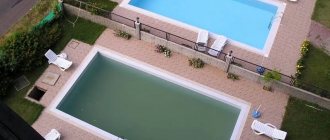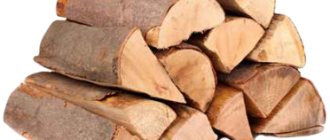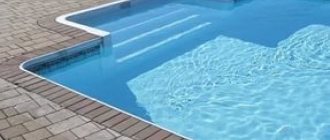On weekends, many residents of our homeland strive to quickly go to their dacha from their cities to breathe fresh air, enjoy nature and take a break from the bustle of the city. And if you have a swimming pool, then the question arises: How to heat a pool in the country?
Swimming in cold water is not fun. And if children also swim with you, they can easily get sick.
Let us remind you that the comfortable water temperature in the pool for an adult is from 25 degrees Celsius, and for children - from +29 degrees.
Today we’ll look at what methods we can use to heat a pool at the dacha. Moreover, we will consider both the devices offered by manufacturers and traditional methods.
Pros and cons of water heaters
The benefits of using gas pool water heaters include the following:
- high efficiency and heating speed;
- ability to work autonomously;
- absence of combustion products;
- simple operation;
- wide selection of models.
Disadvantages of the device:
- the need for a constant gas supply of acceptable pressure;
- constant monitoring of gas leaks;
- strict requirements for the room where the device is installed;
- complexity of connection (services of qualified specialists are required);
- the need for professional service;
- regular monitoring of equipment performance.
Heating by gas boiler
Gas boilers are used to heat large swimming pools. The principle of operation of such water heaters is similar to fuel ones, however, it is not wood or coal that burns, but natural gas or propane. In such devices, water from the pool is pumped into the boiler storage tank. The burning gas releases heat to the liquid. The heated water returns to the pool. Fluid circulation occurs.
Heating with a gas boiler is needed for large swimming pools.
The advantage of this device: even if there is a lot of water in the pool, it will heat up quickly. The disadvantages of gas boilers include the need to obtain permission to install equipment. Installation should only be carried out by a specialist.
Design and principle of operation
The gas burns in the heater, releasing heat, which is transferred to the water passing through the circuit of the device.
The heat exchange device does not heat the water directly. This is an optimization element that increases the efficiency of heat exchange between 2 media: water in the pool and coolant operating from a heat source.
Inside the heat exchanger, they are separated by a system of thin tubes or plates made of a material with high thermal conductivity. The larger the area of this contact, the greater the amount of heat that manages to move from a more heated environment to a less heated one.
A high degree of efficiency and cost-effectiveness of equipment is achieved through the use of natural fuel. The power of the gas heater starts from 115 kW. Propane ensures stable maintenance of a comfortable water temperature for a long period of time.
About the water temperature in the pool
Of course, we determine a comfortable temperature by touch. What if the heating is on? Using the table, you can find out when it is enough to warm up and whether it is possible to swim in cold weather. You will need a water thermometer.
| Age group, type of activity | Temperature |
| Preschoolers | from 29–31°С |
| Children from 7 years old | from 29°С |
| Adults | 25-27°С |
| Elderly | from 26°С |
| Wellness activities | 26-29°С |
| Sports activities, active games | 21–23°С |
| Hydromassage, jacuzzi | 35–39°С |
How to choose?
Gas heaters have the following technical characteristics:
Maximum operating temperature: shows how hot the gas heater coolant can be.- Thermal power: depends not only on the contact area between the two media, but also on the type of liquid being processed.
- Throughput (measured in cubic meters per hour): this parameter shows the time during which the entire volume of water in the pool will pass through the heat exchanger.
After determining the appropriate parameters for the technical characteristics of the gas heater, the required power of this device should be calculated.
To do this, you need to take into account factors:
- pool volume;
- volume of constant heat loss;
- heat source power;
- coolant temperature;
- desired pool water temperature;
- the time period during which water needs to be heated, provided that it has just been collected.
It is advisable to select the power of the equipment corresponding to the maximum level of heat loss. This is enough to maintain an acceptable water temperature during peak loads on the system.
The rules for saving resources are also observed. The lower power limit is selected with a coefficient of 0.7 from the volume of the pool bowl.
Next, you need to calculate the acceptable power of the heat exchanger. To do this, use the formula P = ((V*C * ΔT)/t1) + q*S, where :
- P – required heat exchanger power (W),
- C – specific heat capacity of water at a temperature of 20°C (W/kg*K);
- ΔТ – difference in temperature of cold and hot water (оС),
- t1 – optimal time for heating the entire pool (hours),
- q – heat loss per hour per square meter of water surface (W/m2),
- V – volume of water in the pool (l).
The obtained result is compared with standards. For example, for an outdoor pool, the acceptable power of a gas heater is 1000 W/m2; if the pool is partially closed (a canopy or part of a building), the power should be 620 W/m2. For indoor pools, the described parameter should correspond to 520 W/m2.
An important parameter is the operating time of the heat exchanger to heat the water in the pool to the required value. The calculation is carried out using the formula t = 1.16 * V * T / P, where :
- t – required time in hours;
- V – volume of water in the pool in cubic meters;
- T – required temperature difference in degrees;
- P – declared power.
For example, the initial temperature of the water in the pool is 20 degrees Celsius. It needs to be heated to 26 degrees. The temperature difference is 6 degrees. The volume of the bowl is 30 cubic meters. A heat exchanger with a capacity of 6 kW is also installed. By calculation we get the value 34.8 hours.
How to extend the life of a heater
To prolong the life of expensive and useful equipment, you should take care of its health by providing proper care.
- At temperatures from 0℃ and below, the heater stops operating. The equipment is disconnected from electricity. The water is carefully drained. Open mechanisms and cavities are protected with plastic film. It is advisable to remove removable parts indoors.
- During operation, scale and sediment accumulate inside the heater openings. They are periodically cleaned with a soft brush, otherwise the performance of the heater will drop.
- The solar collector is cleaned from time to time of debris, dust, and snow. Otherwise, the collector will not receive additional heat, and the heating of the water will decrease by several degrees.
- To preserve the temperature and warm up the water faster the next day, the pool is hermetically covered with a dark blanket. Such a blanket will protect the water from heat loss and help avoid clogging with insects, leaves, branches and dust.
Boiler models for heating water with gas, prices
Popular models of gas heaters for swimming pools are the following:
Vanward Tankless
Affordable gas pool heater made in China. Suitable for small medium bowls for home use . Compliance with ISO9001 standards certifies the high quality and safety of the product.
The compact size of the device allows it to be installed in limited spaces. The average cost of such a heater is from 15,000 to 16,000 rubles.
Volcano
Gas heaters of the Vulcan brand are compact, easy to use and efficient . Suitable for stationary, quickly installed and swimming pools.
The supply type of heater requires its connection to a water filtration system, the productivity of which should be in the range from 2 to 9 thousand liters per hour. The cost of the model is 30-35 thousand rubles.
Davey
Davey gas heaters are suitable for large-volume amateur and professional pools. They are used in SPA centers, swimming establishments and private residential properties (country houses, cottages, dachas).
HSI (hot surface ignition) technology has been introduced, which reduces fuel consumption by reducing pilot light consumption. The average cost of the model is about 220-250 thousand rubles.
Heating a pool with a heat pump
Heat pump heaters are a complex design in which water drawn from the pool passes through a filter system and then enters a pump. Inside it, it moves along a coil.
Air pumped from outside collides with the refrigerant, which leads to the formation of a large amount of condensate. This substance, under the influence of temperature differences, quickly turns into steam, and then is pumped into a compressor, where it is compressed to 20-25 atm. This process is accompanied by the release of heat. Such systems are compact.
How to connect to the tank?
Installation and configuration of such equipment for the pool requires highly qualified specialists. Connection is carried out in accordance with the attached instructions. In general, the connection algorithm consists of the following steps:
- Installing the heater on a flat surface near the pool.
- Connecting the hose from the filter system to the lower pipe of the heater.
- Turning on the filter system and releasing air from it.
- Connecting the reducer to the gas cylinder.
How to make a pool warm in both autumn and winter?
You'll have to put the bowl indoors. It could even be a greenhouse covered with a thick film. The main thing is that the pool and all its equipment fit.
The optimal heating option is a wood firebox. It is installed separately, covered from precipitation so that it does not rust. It is recommended to heat the stove with birch wood, the efficiency of which is quite high.
In the greenhouse itself, it is worth installing IR heaters to heat the air. As a result, the author of this option managed to achieve 20°C in the greenhouse and 33°C in the water. By the way, a swimming pool installed in a heated room does not need to be dismantled for the winter.
By insulating the bowl, you will significantly reduce heat loss. After which the temperature of the heated water will be maintained for 2-3 days.
Source of idea: drive2.ru
Even at the stage of installing the pool, consider insulating the bottom or even sinking the bowl into the ground. In this case, you will also need a pool stepladder.
How to use?
To start heating, it is enough to provide gas supply to the device and turn on the equipment with the appropriate switch. Next, after the operating time of the heat exchanger, previously calculated by the appropriate formula, you need to check the temperature in the pool.
It should correspond to the expected value: swimming pools, sports pools - from 24 to 26 degrees Celsius, children's pools - from 28 to 30 degrees Celsius, pools for hydromassage and similar water treatments - from 32 to 38 degrees Celsius.
The simplest solar water heater - DIY instructions
From scrap materials you can make simple solar water heaters that are highly efficient in the summer. Cellular polycarbonate and plastic bottles will serve as a good basis for creating such devices.
Made from cellular polycarbonate
First, a frame is made from a wooden beam. Then a coil is welded from copper tubes in which water will circulate. At its ends, fittings are installed to connect the supply and discharge pipes.
The water heater can be made of cellular polycarbonate.
Plywood is attached to one side of the frame, and insulation is placed on top of it. After this, the coil is fixed to the frame. The top of the structure is covered with a polycarbonate sheet. The finished collector is connected to the pump. In addition, a pipe is installed that drains the liquid back into the pool. You can then turn on and test the system.
From plastic bottles
For the manufacture of the device, containers with a volume of 1.5 liters are better suited. A hole should be drilled in the bottom of each of them, the diameter of which should coincide with the neck. Then one bottle is inserted into the other, secured together with a drilled cap. The connections should be soldered so that they are airtight. In this way, 5-6 containers are fastened in a row.
You need to make at least 5 of these batteries. They are connected to each other with a hose to form a coil. The bottles are painted black. Then the formed coil is placed in a pre-made housing, in which the inlet and outlet holes are made. The top of the heater is covered with transparent polycarbonate or glass.
Other methods of heating an artificial reservoir
Let's look at what devices can be used to heat the water in the pool.
Geyser
The water in the pool can be heated using a household gas water heater .
However, it must be taken into account that this method is only suitable for small-volume remote pools. They are installed on a temporary basis at dachas or on the territory of a country house.
The power of the column must be at least 20 kW. You can easily purchase such a product in any specialized store at a cost of 3 to 6 thousand rubles.
Gas cylinder
Gas can be supplied from a gas cylinder . To connect equipment to such a cylinder, you should first of all pay attention to the thread of the nut (in many heater models the nut has a left-hand thread) that secures the heater connection point. You need to screw it counterclockwise as tightly and carefully as possible.
Next, open the cylinder valve. To do this, you need to rotate it counterclockwise. At this time, you should finally make sure that there is no gas leakage from under the nut.
To make sure that gas does not flow into the burners, you need to unscrew the fuel supply control screw located on the reducer. This is also done counterclockwise until the value on the pressure gauge reaches 0 MPa. Next you need to light the burner.
Before starting you should check:
- is the water circulation turned on?
- are there any leaks;
- is a reducer connected to the cylinder;
- Is the valve open?
Ignition is carried out with a special gas lighter. This is the easiest and safest way to properly light a burner.
When turned on, it is brought to the burner and at the same time the gas supply screw is rotated clockwise. After ignition, you need to set the value to 0.1 MPa on the pressure gauge for stable operation.
Heat exchanger for swimming pool
The heat exchange heater has a cylindrical reservoir and a coil, the inlet and outlet of which are connected to the heating system. Water is taken from the pool and pumped into the tank. Here it is heated and released back into the pool under pressure. To regulate the heating process, such devices are equipped with a thermostat.
The pool heat exchanger has a cylindrical tank.
Advantages and disadvantages
The advantage of heat exchangers is low energy consumption, because Connection to the electrical network requires only a pump, which pumps water into the tank and pushes it back into the pool.
In addition, the positive aspects of the device include:
- high reliability;
- efficiency;
- unpretentiousness to operating conditions;
- long working life.
The main disadvantage of the system is the slow heating of a large volume of water.
Operation of the heat exchanger is possible only in the autumn-winter period, i.e. during the heating season.
What affects heating?
Maintaining the temperature inside the bowl is affected by:
- location of the tank - the temperature directly depends on where it is located - in an open space or inside the house;
- bowl capacity;
- technical characteristics of the heater;
- size, depth and shape of the pool.
Keep in mind that structures located outside do not warm up above 24 degrees - this is a costly and pointless exercise. Large heat losses will quickly reduce the temperature.
Stages of building a winter pool
- Preparing the area. The principle of preparation is the same as for the construction of a conventional stationary pool. The base of the future pool is marked using pegs and a thread stretched between them. Don't forget about good sunlight. Location of groundwater. Removing tree roots.
- Digging a pit. To speed up the process, it is better to call specialized equipment. It will take less time and effort.
- Construction of wooden formwork. It is better to give preference to polystyrene plates. Firstly, they are easier to work with. You can create any fancy shape for your future pool. They fit conveniently into grooves. Secondly, after filling the voids between the polystyrene boards, they do not need to be removed. Slabs and concrete will be a very strong structure. The outer side of the pool bowl must be protected with waterproofing material. It will prevent moisture from contacting the concrete. Protects from groundwater. Heat transfer to the ground will be significantly reduced.
- During the construction of the formwork, all embedded elements, drainage and filling pipes are laid. Heating system. Filtration system. For strength, they are fixed with wire to the reinforcement.
- When pouring concrete, it is necessary to take special, high-quality cement that is capable of constant contact with water. While pouring concrete, stir it to release air. First, metal reinforcement is poured at the bottom of the pool. After complete drying, they begin to fill the walls. Reinforced rods should also be installed between the slabs.
Advice! To fill the bowl, only grades of concrete for swimming pools are used, with water resistance not lower than W4, and strength not lower than class B15 (as before, not lower than M350). The frost resistance grades of concrete for outdoor pools must be at least F200.
- After the concrete structure has dried, finishing work begins. Initially coated with deep penetration mastic. It is able to open the pores of cement and fill voids. Very good protection against moisture getting into concrete cracks. Secondly, apply waterproofing plaster. It can even out surface unevenness and become an additional protective layer. Then they sand it and begin decorative finishing.
- Mosaic tiles are best suited for an outdoor heated pool in winter. It is made of glass, and the water throughput of glass is reduced to zero. Mosaic tiles are not only very high quality tiles, but also beautiful. It can be laid in various options and colors. The final stage is treating the seams with waterproofing grout. They are elastic, hold water well and cushion together with the tiles when loaded with a large volume of water. By the way, this is another plus, many small tiles can take the desired shape while filling the pool with water.
- After the pool is filled with water and all connected systems are checked, it is launched. The heating is turned on gradually to the minimum temperature so that the system adjusts its performance.
Heat loss calculation: Heating a pool using a stove:
Basic Rules
Swimming is not only a pleasant activity - it is also very useful for the prevention and treatment of a number of diseases of the heart, lungs, and bone tissue. The main thing is to create the correct temperature regime. If the water is cold, there is a risk of relapse of chronic diseases. An excessively warm pool will not have an invigorating effect and will not tone your muscles.
The optimal water temperature for adults is 23 degrees, for children - 26.











